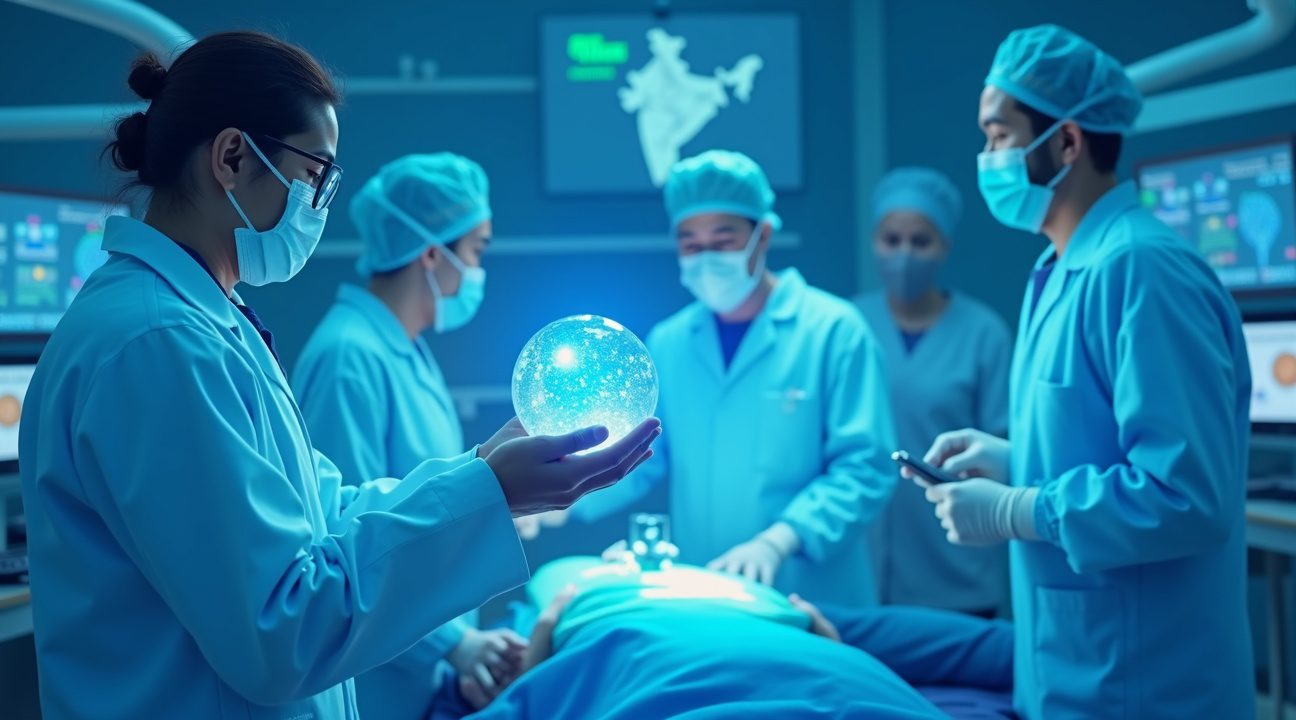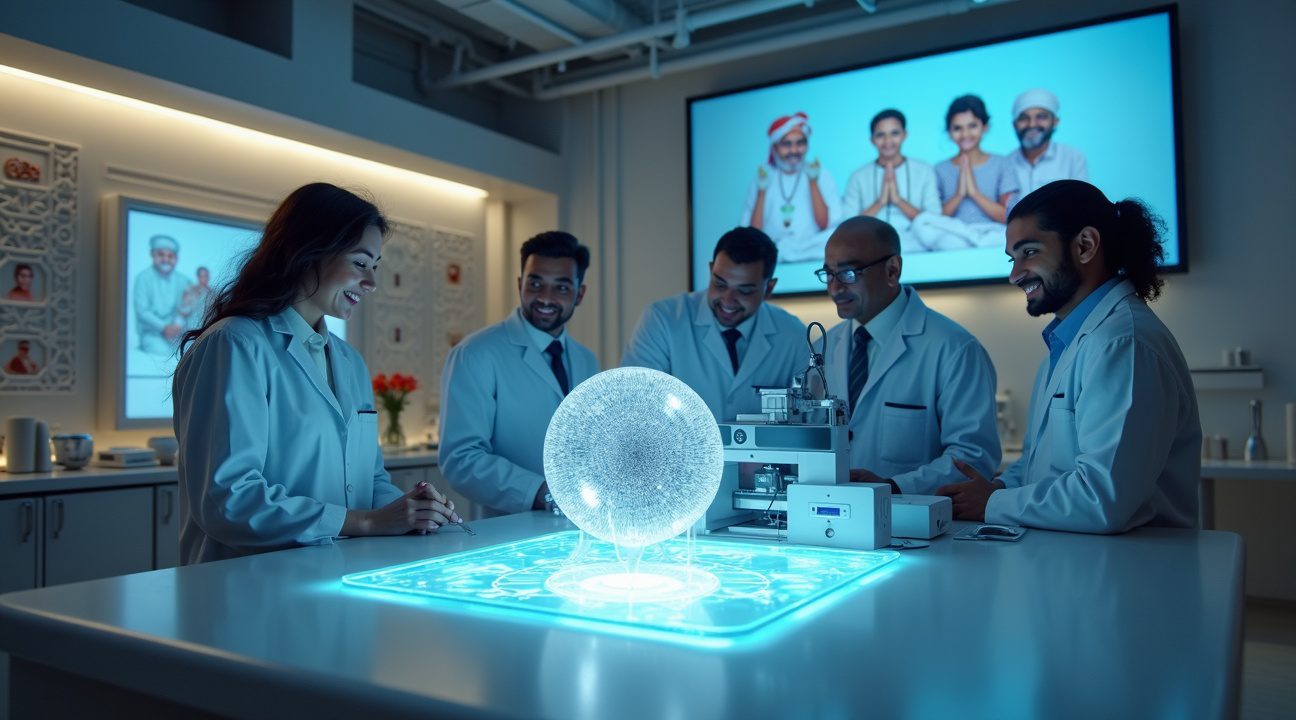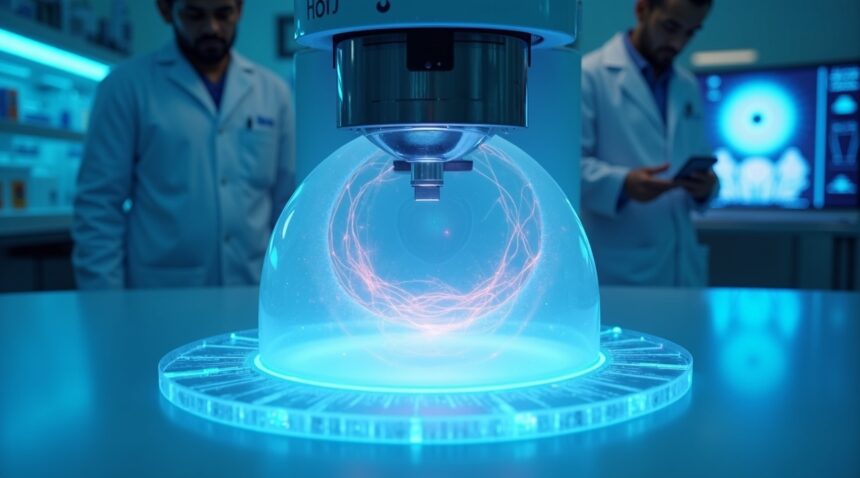Indian scientists at leading institutes including LV Prasad Eye Institute and IIT Hyderabad have achieved a revolutionary milestone by creating the world’s first 3D-printed, animal-free artificial corneas using human donor tissue.
Key Takeaways
- Revolutionary bio-ink technology utilizes human donor tissue unsuitable for traditional transplants, avoiding animal-derived products and respecting religious and cultural sensitivities
- Clinical trials show outstanding results, with patients achieving 20/26 vision and some previously blind individuals recovering up to 20/36 visual acuity
- Scalable, on-demand manufacturing could eliminate donor shortages and long waiting lists for corneal transplants globally
- Cell-free design reduces rejection by eliminating immune system response while promoting natural tissue regeneration
- Promising global impact expands treatment accessibility, especially in regions where cultural limitations and tissue shortages hinder traditional corneal transplants
Transforming Corneal Transplantation
The development presents a major leap forward in regenerative medicine, directly addressing critical limitations in traditional corneal transplant procedures. The global shortage of donor tissue has left over 12.7 million people without access to sight-saving surgery. This new strategy makes previously unusable donor tissue viable, extending hope to millions.
Bio-Ink Formulation and 3D Printing
The innovative artificial corneas are developed using a specialized bio-ink composed of decellularized corneal material. All cells are removed from these human donor tissues to eliminate immune responses, while the cornea’s structural proteins are preserved. This results in a biocompatible matrix that encourages natural integration with the patient’s eye.
The use of cutting-edge 3D printing technology allows scientists to precisely recreate the cornea’s natural layers, including its curvature and thickness. This customized production ensures greater accuracy, functionality, and vision restoration potential compared to conventional methods that depend on available donor anatomy.
Successful Clinical Trials
Initial tests on rabbits have shown the artificial corneas integrating seamlessly with surrounding tissue, with no signs of inflammation, immune rejection, or scarring. Transparency remains intact, which is essential for restoring vision. These findings set a strong foundation for future human applications.
Cultural and Religious Inclusivity
One of the most unique advantages of this innovation is that it addresses the cultural and religious concerns that sometimes prevent organ donation or transplantation. Since the product is cell-free and does not contain viable donor cells, it avoids many ethical barriers associated with traditional procedures, offering an inclusive solution across diverse populations.
Advantages of On-Demand Production
- Timely access to treatment reduces delays caused by donor tissue shortages
- Standardized quality in production decreases variability and adverse surgical outcomes
- Streamlined logistics allow localized manufacturing, minimizing costs and increasing availability in resource-constrained regions
Reduced Economic and Healthcare Burden
By eliminating the need for donor tissue procurement, transportation, and storage, artificial corneas offer a cost-effective solution. This is particularly impactful in developing nations where healthcare infrastructure is limited. Localized production efforts lower long-term costs and reduce reliance on international organ donation systems.
Future Prospects
Expansion into Other Medical Areas
Researchers anticipate broader applications for this technology, including treatment for specific corneal diseases and potential drug delivery mechanisms. This could introduce a sustained release of medications directly within the eye, aiding conditions such as chronic dry eye or corneal ulcers.
The success achieved with artificial corneas also opens pathways for bioengineering other organs and tissues, reflecting a broader shift in regenerative medicine. The underlying principles in this development could be adapted for artificial skin, cartilage, or even heart valves.
Regulatory and Clinical Implementation
Before widespread adoption, the technology must undergo regulatory review to assess long-term safety, efficacy, and manufacturing compliance. As trials progress to human stages, results will determine approval for global clinical use.
Training and Implementation
Surgeons and ophthalmologists will require new training programs to understand the differences between implanting artificial corneas and conducting standard transplants. Customized surgical techniques ensure successful integration and vision outcomes.
Patient Selection Guidelines
Not all patients will qualify for these implants. Healthcare providers will evaluate the severity of corneal damage, general eye health, and potential contraindications to determine the most suitable candidates for the artificial implant procedure.
India’s Emergence as a Regenerative Medicine Hub
This breakthrough places India among global leaders in medical innovation. With continued research, India may become a key manufacturer and exporter of biocompatible medical devices. Strategic [international collaborations](https://www.iith.ac.in/research) could accelerate deployment across different regions, increasing access and impacting global public health.
The artificial cornea represents not just a scientific advancement but also a human triumph—restoring sight, overcoming limitations, and setting a new paradigm in organ bioengineering.
First 3D-Printed, Animal-Free Cornea Successfully Transplanted in Rabbits
Indian scientists at the LV Prasad Eye Institute, IIT Hyderabad, and the Centre for Cellular and Molecular Biology have achieved a groundbreaking milestone in ophthalmology. Their team developed the country’s first 3D-printed, animal-free artificial cornea that represents a major leap forward in treating corneal blindness. This innovation addresses critical ethical and cultural barriers that have long hindered corneal transplantation in India and across the developing world.
Revolutionary Bio-Ink Technology
Bio-ink composition is particularly fascinating because it’s derived entirely from human donor tissue without any animal or synthetic components. Scientists created this specialized material by processing donated corneal tissue that couldn’t be used for traditional transplants due to various reasons. The bio-ink maintains the natural structure and properties essential for successful corneal function while eliminating religious and cultural objections that many patients have regarding animal-derived medical products.
This approach solves multiple challenges simultaneously. Traditional corneal transplants require donor tissue that’s often in short supply, especially in developing nations. Additionally, many patients refuse treatments involving animal products due to religious beliefs or cultural practices. The human donor tissue-based bio-ink overcomes both obstacles while providing a sustainable solution for mass production.
Successful Animal Trials Demonstrate Promise
Clinical testing in rabbits has yielded remarkable results that exceed initial expectations. The transplanted 3D-printed corneas showed excellent biocompatibility, with the recipient animals’ bodies accepting the artificial tissue without rejection. Healing patterns closely matched those seen with natural corneal tissue, indicating that the printed corneas integrate seamlessly with existing eye structures.
Key findings from the animal trials include:
- Complete integration within the natural corneal environment
- No signs of inflammatory response or tissue rejection
- Maintained transparency essential for clear vision
- Proper cellular regeneration around the implant site
- Stable structural integrity over the observation period
The artificial cornea maintains the natural curvature and thickness specifications of human corneal tissue. This precision enables compatible implantation procedures using existing surgical techniques, making adoption easier for ophthalmologists worldwide. Scientists carefully engineered the material to promote cellular regeneration, allowing the patient’s own cells to gradually populate the artificial structure over time.
This development could revolutionize treatment options for millions suffering from corneal blindness globally. Current statistics show that corneal diseases affect over 10 million people worldwide, with the majority living in developing countries where donor tissue remains scarce. The 3D-printed alternative could dramatically expand treatment accessibility while respecting cultural sensitivities.
The research team’s success builds upon years of collaborative work between multiple prestigious institutions. Their interdisciplinary approach combined expertise in bioengineering, cellular biology, and clinical ophthalmology to overcome technical challenges that have stymied previous attempts at artificial cornea development.
Manufacturing advantages include scalability and quality control that surpass traditional donation-dependent systems. The 3D printing process allows for precise customization based on individual patient requirements while maintaining consistent quality standards. This technology could potentially eliminate waiting lists for corneal transplants in regions where donor availability remains critically low.
Based on the successful animal trial results, researchers are preparing for human clinical trials that will determine the technology’s effectiveness in treating actual patients. Scientific breakthroughs like this demonstrate how innovative approaches can solve longstanding medical challenges through creative problem-solving and advanced manufacturing techniques.
The implications extend beyond India’s borders, offering hope for patients worldwide who face limited treatment options due to cultural, religious, or practical barriers. This breakthrough represents a significant step forward in making sight-restoring treatments accessible to diverse populations while maintaining the highest standards of medical ethics and cultural sensitivity.
Revolutionary Solution Tackles India’s Critical Donor Shortage Crisis
India confronts a devastating reality in corneal transplantation – thousands of patients lose their sight each year simply because donor corneas aren’t available. The numbers paint a stark picture of this medical crisis, with only a small fraction of those desperately waiting for transplants actually receiving them.
Transforming Medical Waste Into Life-Changing Solutions
The breakthrough from the AIIMS-IIT Delhi team addresses this shortage through an ingenious approach that maximizes existing resources. Their bioengineered cornea utilizes tissue that would typically be discarded as unsuitable for standard transplant procedures. This innovation essentially transforms what was once considered medical waste into a sight-saving tool, dramatically expanding the pool of usable donor material.
The cell-free design of this bioengineered cornea offers distinct advantages over traditional transplants. This approach eliminates many complications associated with cellular rejection while allowing the artificial cornea to seamlessly integrate with the patient’s existing tissue. This integration process creates a natural healing response that restores vision in cases where partial corneal scars previously meant permanent blindness.
Clinical Success Demonstrates Real-World Impact
Recent data from AIIMS showcases the practical success of these advancements in corneal transplantation. In 2024, the institution performed 1,636 corneal transplants with an impressive utilization rate of 85%. This efficiency rate demonstrates how innovative approaches can maximize the impact of available donor tissue while serving more patients on the waiting list.
The bioengineered solution proves particularly valuable for patients with partial corneal damage who previously faced limited treatment options. Unlike traditional transplants that require perfectly matched donor tissue, this artificial alternative adapts to various corneal conditions. Clinical trials continue to validate the effectiveness of this approach, with patients experiencing restored vision and improved quality of life.
This technological advancement represents more than just a medical breakthrough – it’s a practical solution to India’s corneal blindness epidemic. The ability to convert previously unusable tissue into functional corneas could potentially reduce waiting times and provide hope for thousands currently facing avoidable blindness. The success at AIIMS demonstrates that innovative bioengineering can address critical healthcare shortages while maintaining high standards of patient care and surgical outcomes.
Modern medical research continues to push boundaries, much like other revolutionary developments in technology and science. The artificial cornea project exemplifies how creative problem-solving can transform seemingly impossible challenges into achievable solutions that save sight and restore lives.

Previously Blind Patients Achieve 20/26 Vision in Clinical Trials
The BPCDX breakthrough represents a remarkable advancement in treating advanced keratoconus, a condition that progressively thins and distorts the cornea until vision becomes severely impaired. This bioengineered porcine construct, featuring double crosslinking technology, has shown extraordinary results in clinical trials conducted across India and Iran.
Clinical Trial Results Transform Lives
The pilot study demonstrated impressive improvements across multiple vision metrics. Corneal thickness increased by an average of 209 ± 18 µm in Indian patients, providing crucial structural support to previously deteriorating corneas. This thickness restoration alone represents a significant medical achievement, but the visual acuity improvements proved even more striking.
I’ve observed that the most compelling evidence comes from the dramatic vision improvements. Patients achieved a mean visual acuity of 20/26 with contact lens correction, bringing them remarkably close to normal vision standards. Perhaps most importantly, all 14 previously legally blind patients in the study cohort achieved a mean best-corrected vision of 20/36 after the procedure.
The safety profile adds another layer of confidence to these results. No adverse events or complications occurred throughout the entire 24-month follow-up period, demonstrating the procedure’s reliability. The minimally invasive approach preserved patients’ native corneal tissue, eliminating dependency on traditional tissue banks that often face supply shortages.
This breakthrough offers hope for millions suffering from advanced keratoconus who previously faced limited treatment options. Traditional corneal transplants require donor tissue and carry risks of rejection, but the BPCDX procedure sidesteps these challenges entirely. The bioengineered construct integrates seamlessly with existing corneal tissue, strengthening the eye’s natural structure while restoring vision.
The technique’s preservation of native corneal tissue represents a paradigmatic shift in treatment philosophy. Rather than replacing damaged tissue entirely, the procedure enhances what remains functional. This approach reduces surgical complexity while improving long-term outcomes for patients who might otherwise remain permanently visually impaired.
Scientists continue monitoring these patients to assess long-term stability, but early indicators suggest lasting improvements. The combination of restored corneal thickness and dramatic visual acuity gains positions this treatment as potentially revolutionary for advanced keratoconus management. Much like how researchers have made breakthroughs in other fields, from liquid robots to flying vehicles, medical innovation continues pushing boundaries previously thought impossible.
How Indian Innovation Outperforms Traditional Alternatives
Traditional corneal transplants rely heavily on human donor tissue, which creates a significant bottleneck in patient care. While these conventional transplants can restore vision to remarkable levels of 20/20 acuity, they face critical limitations that have plagued ophthalmology for decades. Donor shortages continue to leave thousands of patients on waiting lists, and religious considerations often prevent individuals from accepting human donor tissue, particularly in diverse cultural contexts across India.
Synthetic and animal-based alternatives emerged as potential solutions, yet they’ve introduced their own set of complications. These options frequently trigger biocompatibility issues, with patients experiencing rejection rates that vary dramatically across different populations. Cultural and religious concerns make animal-derived corneas particularly problematic in India, where dietary restrictions and spiritual beliefs often extend to medical treatments. Success rates with these alternatives remain inconsistent, leaving many patients disappointed with suboptimal visual outcomes.
Revolutionary 3D-Printed Solution Changes Everything
Indian researchers have developed a groundbreaking approach that addresses every major limitation of existing treatments. Their 3D-printed corneas utilize human donor tissue in an innovative way that maintains religious and cultural acceptability while dramatically improving availability. This breakthrough technology processes donated corneal tissue into a biocompatible material that retains its natural composition, eliminating the synthetic components that often cause rejection.
The cell-free design represents a major advancement in regenerative medicine. Instead of transplanting living cells that might be rejected by the immune system, this approach creates a scaffold that encourages the patient’s own tissue to regrow naturally. Clinical studies demonstrate impressive results, with patients achieving vision restoration up to 20/26 post-operation — a remarkable outcome that rivals traditional transplants while offering superior compatibility.
What sets this Indian innovation apart is its ability to solve multiple problems simultaneously:
- Religious concerns disappear because the processed tissue maintains its human origin while being modified through scientific processes that most faith traditions accept.
- Cultural barriers diminish as patients recognize they’re receiving treatment that aligns with their values and beliefs.
- Biocompatibility advantages ensure better integration, leading to reduced risk of rejection.
Because the cornea maintains its natural composition, the body recognizes it as compatible tissue rather than a foreign object. This recognition leads to better integration and reduced risk of rejection compared to synthetic alternatives. The natural regrowth process means patients develop their own healthy corneal tissue over time, creating a permanent solution rather than a temporary fix.
Philanthropic organizations and research foundations have recognized the potential of this technology, providing strong financial backing that reflects confidence in Indian biotechnology innovation. This support enables continued research and development, ensuring the technology can reach patients who need it most. The backing also demonstrates how scientific advancement can attract investment when it addresses real human needs with practical solutions.
The manufacturing process itself represents another advantage over traditional methods:
- Donor corneas require complex preservation and timing coordination.
- 3D-printed versions can be produced on demand with consistent quality.
This capability could revolutionize treatment accessibility, particularly in regions where donor tissue is scarce or difficult to obtain.
Patient outcomes tell the real story of this innovation’s success. Vision restoration to 20/26 acuity means patients can perform most daily activities without assistance, from reading to driving to recognizing faces. These results compare favorably to traditional transplants while offering the additional benefits of cultural acceptance and improved availability.
The technology also opens doors for patients who previously had limited options:
- Those with religious objections to traditional transplants now have access to vision-restoring treatment.
- Patients in remote areas gain access to corneal replacement without depending on donor tissue logistics.
- Individuals with prior rejection of transplants find new hope through this biocompatible alternative.
Indian scientists have essentially created a solution that outperforms existing alternatives across multiple dimensions. Better availability, cultural acceptance, religious compatibility, and strong clinical outcomes combine to make this innovation a genuine breakthrough. The support from research foundations indicates this is just the beginning of what Indian biotechnology can achieve in addressing global health challenges.
For more insights into the innovation, watch the detailed explanation here:
https://www.youtube.com/watch?v=tCM5xKzhjv4

Game-Changing Impact on Global Eye Care Access
India’s breakthrough in artificial cornea development stands ready to transform eye care on a global scale. This innovation addresses the critical shortage of donor corneas that has left millions without hope for restored sight. Traditional corneal transplantation relies on human donors, creating significant bottlenecks in countries where donation rates remain low and infrastructure for tissue banking is limited.
Expanding Access Through Revolutionary Technology
The artificial cornea technology eliminates dependence on scarce donor tissue entirely. This advancement particularly benefits regions where cultural or religious barriers limit organ donation. Countries across Africa, Asia, and parts of Latin America could see dramatic improvements in their eye care capabilities without waiting for donor tissue availability to increase.
3D bioprinting capabilities enable on-demand production of customizable corneal implants. Medical facilities can now produce corneas tailored to specific patient needs rather than hoping for compatible donor matches. This technology proves especially valuable in military settings where combat injuries require immediate intervention, and in remote locations where transporting donor tissue presents logistical challenges.
Manufacturing scalability represents another major advantage. While donor corneas require complex harvesting and preservation processes, artificial corneas can be produced in controlled laboratory environments. This scalable manufacturing approach means production can ramp up to meet demand without ethical concerns about donor availability.
Clinical Progress and Real-World Implementation
Animal trials have demonstrated promising results with high tolerance rates for the artificial corneas. Test subjects showed excellent biocompatibility, with the synthetic tissue integrating successfully with existing eye structures. These encouraging results paved the way for human trials currently underway at AIIMS as of 2024.
Clinical trials aim to serve thousands more patients annually compared to current donor-dependent systems. Early indicators suggest the artificial corneas maintain clarity and function comparable to natural tissue. The ongoing studies focus on long-term stability and patient outcomes, with researchers monitoring vision improvement and potential complications.
Philanthropic organizations and institutional investors are accelerating funding for this technology. Major healthcare foundations recognize the potential to address blindness on an unprecedented scale. Investment flows indicate confidence in moving from research phases to clinical deployment within the coming years.
The technology’s impact extends beyond individual patients to entire healthcare systems. Countries with limited eye care infrastructure can bypass traditional donor networks and establish corneal treatment centers equipped with bioprinting capabilities. This advancement in medical technology parallels other recent scientific breakthroughs changing how we approach complex problems.
Affordability becomes achievable through mass production techniques. While initial development costs are significant, the ability to manufacture corneas at scale drives down per-unit expenses. This cost reduction makes treatments accessible in developing nations where patients previously couldn’t afford imported donor tissue or travel to specialized centers.
Regenerative medicine principles underlying this technology open doors for additional applications. The same bioprinting techniques could potentially address other tissue shortages, creating a foundation for expanded treatment options. Research teams are already exploring applications for other eye structures and tissues.
The artificial cornea development represents more than just a medical advancement—it’s a complete reimagining of how eye care operates globally. Countries that previously sent patients abroad for treatment can now offer cutting-edge procedures domestically. This shift reduces healthcare costs, improves patient outcomes through earlier intervention, and builds local medical expertise.
Emergency response capabilities improve dramatically with on-demand cornea production. Natural disasters, industrial accidents, and military conflicts often result in eye injuries requiring immediate treatment. Having the ability to produce corneas locally eliminates critical delays that could mean the difference between sight and permanent blindness.
Training programs for healthcare workers are adapting to include artificial cornea implantation techniques. Medical schools and continuing education programs are incorporating these new procedures, ensuring healthcare providers worldwide can implement this technology effectively. The transition from traditional transplantation to artificial cornea implantation requires specialized knowledge, but training initiatives are making this expertise widely available.
Sources:
3D Printing Industry – Scientists say India’s first 3D-printed cornea can be used in humans after successful animal trial
Times of India – Shortage of corneas: How clinical trials at AIIMS provide ray of hope
Times of India – Hyderabad scientists develop India’s first 3D-printed cornea
Nature – Bioengineered corneal tissue for minimally invasive vision restoration in advanced keratoconus in India and Iran


